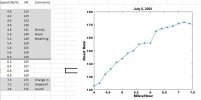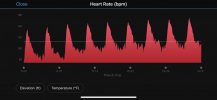barrak
Level 6 Valued Member
My PT prescribed a Conconi test for me which revealed some interesting data points that may interest some readers. It was done on a treadmill, with each speed increment lasting 60 seconds. Readings were recorded off a Polar H10 chest strap monitor.
Thanks to the kettlebell programs I've been doing over the past 4 years, I've maintained my max HR at 172, with a decent anaerobic/lactate threshold at 155 (read at the deflection point in the curve). From this data, my VO2max is very decent for my age group; 40-42 at age 56. (see calculation below the graph)
However, notice the slow speeds and how quickly my HR rises at the start of the test. From what I read online: Aerobic Threshold Pace = 70% of VO2max Pace (7.2 miles/hr) = 5 miles/hr. My PT is not convinced this estimate applies in my case and believes my aerobic threshold is much lower. I'm under strict orders from him to limit my runs to sub 125 HR for several weeks to start building my aerobic capacity.
This is a very humbling prescription. I tried it yesterday for an hour and had to repeatedly slow down to a walk to stay within the target 110-124 HR. My previous "easy" runs, which I started 3 weeks ago, have been in the 125 - 140 HR range.
I'm bringing this all up for the benefit of others like me who neglected/are neglecting training their entire heart rate zone ranges.
I'm also open to suggestions and corrections if I'm grossly misinterpreting my data.

Estimating VO2max using a measured (not estimated) maxHR :
1. Pick a running speed in miles/hour (S) at a 90%+ of maxHR (P). In my case, I chose S = 7.2 at P = 100% = 1
2. Convert speed to meters/minute ==> 26.8 x S
3. Work Vo2 = 26.8 x S x 0.2 + 3.5
4. Vo2max = Work Vo2 / P = ( 26.8 x 7.2 x 0.2 + 3.5 ) / 1 = 42
Reference: https://www.ncsf.org/pdf/ceu/relationship_between_percent_hr_max_and_percent_vo2_max.pdf
Thanks to the kettlebell programs I've been doing over the past 4 years, I've maintained my max HR at 172, with a decent anaerobic/lactate threshold at 155 (read at the deflection point in the curve). From this data, my VO2max is very decent for my age group; 40-42 at age 56. (see calculation below the graph)
However, notice the slow speeds and how quickly my HR rises at the start of the test. From what I read online: Aerobic Threshold Pace = 70% of VO2max Pace (7.2 miles/hr) = 5 miles/hr. My PT is not convinced this estimate applies in my case and believes my aerobic threshold is much lower. I'm under strict orders from him to limit my runs to sub 125 HR for several weeks to start building my aerobic capacity.
This is a very humbling prescription. I tried it yesterday for an hour and had to repeatedly slow down to a walk to stay within the target 110-124 HR. My previous "easy" runs, which I started 3 weeks ago, have been in the 125 - 140 HR range.
I'm bringing this all up for the benefit of others like me who neglected/are neglecting training their entire heart rate zone ranges.
I'm also open to suggestions and corrections if I'm grossly misinterpreting my data.

Estimating VO2max using a measured (not estimated) maxHR :
1. Pick a running speed in miles/hour (S) at a 90%+ of maxHR (P). In my case, I chose S = 7.2 at P = 100% = 1
2. Convert speed to meters/minute ==> 26.8 x S
3. Work Vo2 = 26.8 x S x 0.2 + 3.5
4. Vo2max = Work Vo2 / P = ( 26.8 x 7.2 x 0.2 + 3.5 ) / 1 = 42
Reference: https://www.ncsf.org/pdf/ceu/relationship_between_percent_hr_max_and_percent_vo2_max.pdf

